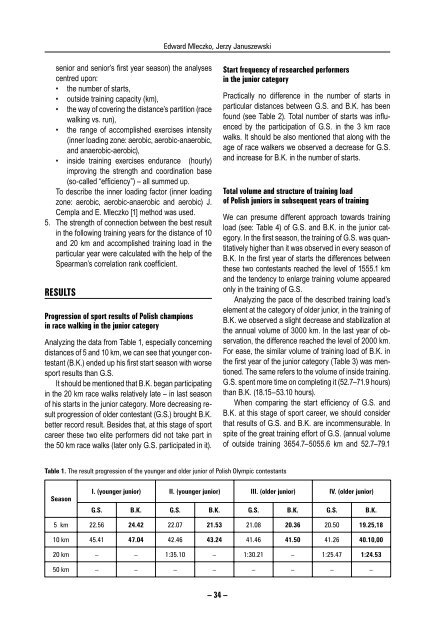Antropomotoryka nr 51 - Akademia Wychowania Fizycznego w ...
Antropomotoryka nr 51 - Akademia Wychowania Fizycznego w ...
Antropomotoryka nr 51 - Akademia Wychowania Fizycznego w ...
- No tags were found...
You also want an ePaper? Increase the reach of your titles
YUMPU automatically turns print PDFs into web optimized ePapers that Google loves.
Edward Mleczko, Jerzy Januszewskisenior and senior’s first year season) the analysescentred upon:• the number of starts,• outside training capacity (km),• the way of covering the distance’s partition (racewalking vs. run),• the range of accomplished exercises intensity(inner loading zone: aerobic, aerobic-anaerobic,and anaerobic-aerobic),• inside training exercises endurance (hourly)improving the strength and coordination base(so-called “efficiency”) – all summed up.To describe the inner loading factor (inner loadingzone: aerobic, aerobic-anaerobic and aerobic) J.Cempla and E. Mleczko [1] method was used.5. The strength of connection between the best resultin the following training years for the distance of 10and 20 km and accomplished training load in theparticular year were calculated with the help of theSpearman’s correlation rank coefficient.RESULTSProgression of sport results of Polish championsin race walking in the junior categoryAnalyzing the data from Table 1, especially concerningdistances of 5 and 10 km, we can see that younger contestant(B.K.) ended up his first start season with worsesport results than G.S.It should be mentioned that B.K. began participatingin the 20 km race walks relatively late – in last seasonof his starts in the junior category. More decreasing resultprogression of older contestant (G.S.) brought B.K.better record result. Besides that, at this stage of sportcareer these two elite performers did not take part inthe 50 km race walks (later only G.S. participated in it).Start frequency of researched performersin the junior categoryPractically no difference in the number of starts inparticular distances between G.S. and B.K. has beenfound (see Table 2). Total number of starts was influencedby the participation of G.S. in the 3 km racewalks. It should be also mentioned that along with theage of race walkers we observed a decrease for G.S.and increase for B.K. in the number of starts.Total volume and structure of training loadof Polish juniors in subsequent years of trainingWe can presume different approach towards trainingload (see: Table 4) of G.S. and B.K. in the junior category.In the first season, the training of G.S. was quantitativelyhigher than it was observed in every season ofB.K. In the first year of starts the differences betweenthese two contestants reached the level of 1555.1 kmand the tendency to enlarge training volume appearedonly in the training of G.S.Analyzing the pace of the described training load’selement at the category of older junior, in the training ofB.K. we observed a slight decrease and stabilization atthe annual volume of 3000 km. In the last year of observation,the difference reached the level of 2000 km.For ease, the similar volume of training load of B.K. inthe first year of the junior category (Table 3) was mentioned.The same refers to the volume of inside training.G.S. spent more time on completing it (52.7–71.9 hours)than B.K. (18.15–53.10 hours).When comparing the start efficiency of G.S. andB.K. at this stage of sport career, we should considerthat results of G.S. and B.K. are incommensurable. Inspite of the great training effort of G.S. (annual volumeof outside training 3654.7–5055.6 km and 52.7–79.1Table 1. The result progression of the younger and older junior of Polish Olympic contestantsSeasonI. (younger junior) II. (younger junior) III. (older junior) IV. (older junior)G.S. B.K. G.S. B.K. G.S. B.K. G.S. B.K.5 km 22.56 24.42 22.07 21.53 21.08 20.36 20.50 19.25,1810 km 45.41 47.04 42.46 43.24 41.46 41.50 41.26 40.10,0020 km – – 1:35.10 – 1:30.21 – 1:25.47 1:24.5350 km – – – – – – – –– 34 –





![Antropomotoryka nr 57 [2012]. - Akademia Wychowania Fizycznego ...](https://img.yumpu.com/50213388/1/182x260/antropomotoryka-nr-57-2012-akademia-wychowania-fizycznego-.jpg?quality=85)










